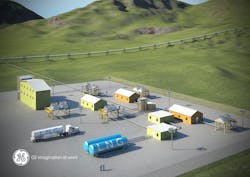Rapid local LNG delivery in the works
A new approach that entails manufacturing liquefied natural gas (LNG) at “micro plants” and then delivering it to nearby truckstops for fueling long-haul trucks promises to help quickly build out what’s trademarked as “America’s Natural Gas Highway” by Clean Energy Fuels,the largest provider of natural gas fuel for transportation in North America.
The new manufacturing/distribution system was detailed in a conference call with reporters held by Clean Energy Fuels and GE. The two firms announced what they termed a “collaboration” to expand the infrastructure for natural gas transportation in the U.S.
They said the agreement supports Clean Energy’s efforts to develop “America’s Natural Gas Highway,” a fueling network that will “enable trucks to operate on LNG coast to coast and border to border.”
Per the deal, Clean Energy Fuels will initially purchase two ecomagination-qualified “MicroLNG” plants from GE Oil & Gas.
Mike Hosford, general manager of Unconventional Resources for GE Oil & Gas, described the micro production plants/distribution terminals as “plug-and-play modular units designed to rapidly liquefy natural gas while minimizing a site’s physical footprint. They will support fueling stations along critical transportation corridors that run across the U.S.”
GE Energy Financial Services is providing up to $200 million in financing for the two GE MicroLNG plants.
Andrew J. Littlefair, president & CEO of Clean Energy Fuels , said his firm plans to use a standardized design of the new GE MicroLNG plants to build additional such plants. The first two MicroLNG plants will produce up to 250,000 gallons per day or or about 54 million DGEs (diesel gallon equivalents) per year.But each plant is designed to be expanded up to 1-million gallons per day as LNG adoption and demand increases.
The LNG produced by the MicroLNG plants will be used primarily at Pilot-Flying J trucks tops, advised Littlefair. “The distribution of LNG will start at the micro plant and from there reach the truckstops,” he explained. “A pipeline goes into the micro plant where the gas is liquefied and then loaded into cryogenic tanker trucks for delivery to the truckstops’ cryogenic storage tanks. The idea is for each plant to support truckstops within a 250-mile radius, as it becomes less economical to haul it further.”
The two GE MicroLNG plants are targeted to begin operation in 2015. The two companies are currently assessing the best locations for the first two plants, but Littlefair noted they will be most likely be sited in the upper Midwest and Northeast.
He also pointed out that the arrival next year of more LNG truck engine models will help drive up interest in this alternative fuel in long-haul applications. “In 2013, four major truck manufacturers will introduce the Cummins Westport 12-liter LNG engine, which is the optimum size for long-haul Class 8 trucks. Eventually, LNG demand will require building dozens and dozens of these micro plants.”
“The agreement announced today with GE is one of the most significant milestones in Clean Energy’s history,” stated Littlefair “As the long-haul trucking industry begins its transition to natural gas, it will be critical to have a reliable supply of LNG. No other company is as uniquely qualified as GE to help address this need due to its vast experience in energy, technology innovations and financing capabilities.
“GE partnering with Clean Energy on these two facilities will not only help ensure an adequate LNG supply for our stations,” he continued, “but it is another confirmation that the transition to natural gas as a transportation fuel is gaining momentum.”
However, Clean Energy is certainly not waiting for the micro plants to come online to further expand its LNG fueling network. Littlefair said the company has 74 or 75 LNG fueling stations in place already and expects to complete approximately 70 more by the end of 2012. “We’ll have a similar [station] build as this year next year,” he advised.
Littlefair added that the LNG fueling being rolled out at its fueling stations is targeted specifically at long-haul, heavy-duty trucks, “which will have the advantage of longer driving ranges while not impacting tractor weight and incremental costs.”
